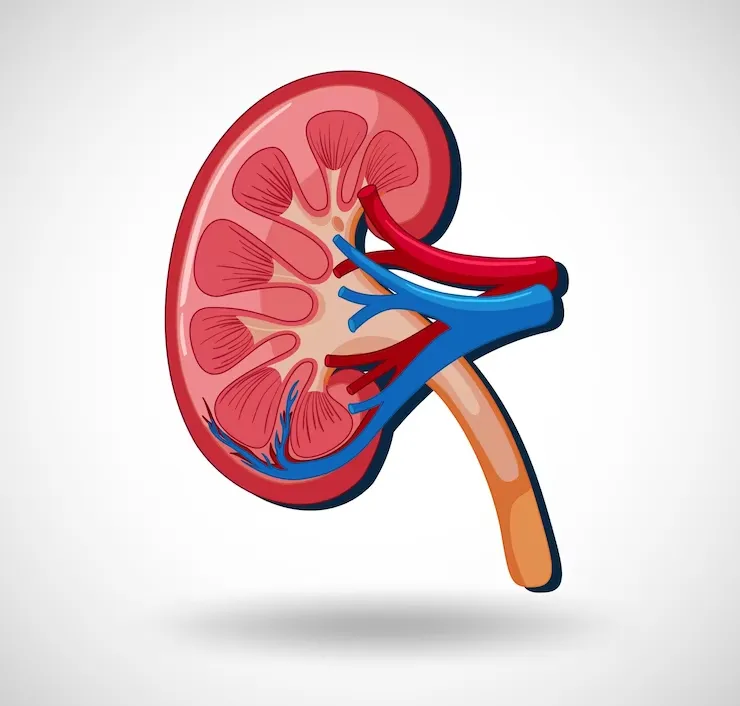发布时间:2024-12-24 浏览:150次
近年来,宿主-肠道菌群的相互作用一直是研究者关注的焦点[1] 。肠道菌群的代谢紊乱可导致一系列疾病的发生,如肥胖、2型糖尿病、炎性肠病、心血管疾病等[2] ,同时也参与了肾脏疾病的发生发展 [3-4] 。
短链脂肪酸(short-chain fatty acids,SCFAs)是肠道菌群的主要代谢产物,其中乙酸、丙酸和丁酸占95%。SCFAs不仅在肠道中具有重要作用,而且作为信号分子,进入全身循环,在慢性肾脏病(chronic kidneydiseases,CKD)中发挥重要作用。本文就 SCFAs在CKD中的主要作用及其机制进行综述。
1 SCFAs的基本概述
SCFAs是链长度为1~6个碳原子的饱和脂肪酸,是结肠中膳食纤维发酵的主要产物,其中乙酸、丙酸和丁酸是人体中含量最丰富的SCFAs,约占总量的95%[5] 。
乙酸主要由肠道内的拟杆菌属、双歧杆菌属、真杆菌属、瘤胃球菌属、消化链球菌属、梭菌属和链球菌属发酵产生;丙酸主要由梭菌属产生;丁酸主要由拟杆菌属、真杆菌属和梭菌属发酵产生[6] 在结肠中产生后,SCFAs主要通过单羧酸盐转运蛋白1和钠偶联的单羧酸盐转运蛋白1介导的主动转运被结肠细胞快速吸收[7] 。
SCFAs可作为结肠上皮细胞的主要能量来源,对于维持肠上皮细胞形态与功能以及肠道黏膜屏障的完整性发挥重要作用[8] 。36%乙酸、9%丙酸和2%丁酸可进入全身循环和外周组织[9] ,与 G 蛋白偶联受体 GPR41、GPR43、GPR109A和 Olfr78 结合或直接抑制组蛋白脱乙酰酶(histonedeacetylase,HDAC)活性而发挥生物学作用。
2 肾病患者SCFAs含量的变化
最新研究表明,CKD 5期患者粪便和血液中丁酸含量与CKD 1~4期存在显著差异[10] ;随着CKD进展,产丁酸的细菌丰度不断降低,粪便和血液中丁酸含量平行减少。Wang等[11] 的研究表明,终末期肾病(end-stage renal disease,ESRD)患者血清和粪便代谢组谱具有很强的协同性,推测粪便和血清丁酸含量也具有相关性。

在 CKD 5 期患者中,肠道产SCFAs的细菌丰度显著减少,主要表现为产丁酸盐的 Prevotella、Roseburia 和 Faecalibacterium prausnitzii菌群丰度下降,且这些菌群的丰度与肾功能呈负相关[10-11] 。这些发现表明肾病患者体内SCFAs含量发生改变,与其肠道产SCFAs的菌群丰度减少有关,且降低程度与疾病进展呈正相关。将CKD 5期患者的肠道菌群移植到5/6肾切除SD大鼠中,与对照组相比,肾功能明显恶化,肾脏纤维化加剧,而补充丁酸钠可显著减轻纤维化[11] 。
肾病患者体内产SCFAs菌群的减少,可能与CKD/ESRD患者肠道中产脲酶、尿酸酶、对甲酚和吲哚形成酶的细菌增加而恶化肠道环境并改变其组成有关[12] 。此外,CKD患者饮食上限制富含纤维食物的摄入亦有可能导致产SCFAs菌群的减少[12] 。我们前期研究发现糖尿病肾病(dia‐betic nephrology,DN)组血清总 SCFAs、乙酸和丁酸水平低于糖尿病组,血清总SCFAs、乙酸、丙酸、丁酸与估算的肾小球滤过率呈正相关。
3 SCFAs在CKD中的作用机制
3. 1 抑制炎症反应
持续的微炎症状态被认为是CKD的特征,这与患者体内促炎细胞因子产生增加、氧化应激及酸中毒,慢性反复感染、脂肪组织代谢的改变以及肠道菌群失调有关[13] 。
临床研究发现,给予维持性血液透析患者丙酸钠后,炎症指标C-反应蛋白、白细胞介素2(interleukin-2,IL-2)、IL-17、IL-6和肿瘤坏死因子 α(tumor necrosis factor-α,TNF-α)下降,而抗炎因子IL-10增加[14] 。SCFAs不仅可减轻CKD和DN因炎症反应引起的肾损伤,也可减轻甚至逆转急性肾损伤(acute kidney injury,AKI)[15] 。Gong等[15] 发现SCFAs不仅抑制促炎细胞因子和趋化因子[如IL-1β、IL-6、TNF-α和单核细胞趋化蛋白1(mono‐cyte chemotactic protein 1,MCP-1)]的产生,且肾脏上皮细胞中核因子κB(nuclear factor-κB,NF-κB)的活化被抑制。在与炎症和纤维化有关的各种急性和慢性肾脏损伤中,NF-κB发挥着至关重要的作用[16] 。
SCFAs对NF-κB的抑制作用,Schilderink等[17] 认为其可能通过抑制HDAC的活性而发挥作用,McNabney等[18] 则称丁酸通过泛素酶A20的内源性表达进而抑制 NF-κB,此外,SCFAs 还可作用于 GPR43-β-arres‐tins通路抑制 NF-κB[19] NF-κB表达增加总伴随着丝裂原活化蛋白激酶(mitogen-activated protein ki‐nase,MAPK)的激活,丙酸钠可显著降低TNF-α诱导的肾皮质上皮细胞 p38 MAPK 磷酸化,进而减轻MCP-1引起的炎症反应[20] 。
SCFAs不仅通过信号转导发挥抗炎作用,而且还通过被动扩散或转运蛋白(MCT1/4和SMCT1/2)直接进入免疫细胞而发挥抗炎作用[21] 。在树突状细胞和巨噬细胞中,SCFAs主要通过抑制 HDAC 活性而抑制IL-6和IL-12表达,从而发挥抗炎作用[21-22] 。在中性粒细胞和脂多糖刺激的单核细胞中,SCFAs通过抑制TNF-α表达、NF-κB信号通路和HDAC活性,促进抗炎细胞因子IL-10的产生而发挥作用[21] 。此外,SCFAs还可通过内皮细胞调节炎症反应[21] ,已知其可减少内皮细胞中IL-6和环加氧酶2的表达[23] 。
总之,SCFAs可通过降低炎症因子,上调抗炎因子表达,抑制NF-κB和MAPK信号通路以及作用于免疫细胞和内皮细胞而发挥抗炎作用。此外,SCFAs也可改善炎症所致的CKD患者铁代谢异常,但其具体机制目前尚不清楚[14] 。CKD患者炎症状态改善后可观察到体内转铁蛋白饱和度增加、铁蛋白降低和血红蛋白上升[14] ,后两者进一步与死亡率相关 [24-25] 。

3. 2 抑制氧化应激
肾脏是人体耗氧量第二大的器官,肾脏细胞内富含线粒体,以满足其高代谢需求,因此也极易产生活性氧(reactive oxygen species,ROS)和氧化损伤。ROS可能与DN或原发性肾脏病变引起的蛋白尿有关[26-27] 。ROS的过量产生可触发下游炎症级联反应[26] ,加剧炎症状态,引起肾脏纤维化[28] 和 CKD 的进展 [29] 。
在脓毒症诱导的AKI 模型中,Al-Harbi等[30] 发现乙酸盐可通过HDAC途径抑制T细胞诱导的NOX2/ROS信号通路而产生抗氧化应激作用,减少了肾小管细胞的空泡化,减轻了肾脏损伤。Huang等[31] 发现,乙酸和丁酸或 GPR43激动剂可显著抑制高糖和脂多糖诱导的肾小球系膜细胞增殖,逆转ROS和丙二醛的产生,并且增加超氧化物歧化酶水平,在DN中发挥抗氧化作用;而且SCFAs与GPR43结合,抑制高糖诱导肾小球系膜细胞中IκBα降解和 NF-κB p65 磷酸化,减少 ROS 和丙二醛生成[32] ,有效改善DN肾功能和肾组织病理变化,包括降低尿蛋白肌酐比值、血清肌酐和胱抑素C水平及抑制肾小球系膜细胞扩张和胶原蛋白沉积[32] 给予维持性血液透析患者丙酸可降低其体内丙二醛浓度和谷胱甘肽过氧化物酶活性,减少氧自由基总体浓度及氧化应激水平[14] 。
SCFAs抑制氧化应激的作用可能与其调节氧化还原酶活性(如谷胱甘肽还原酶、谷胱甘肽过氧化物酶和过氧化氢酶)和P300介导的核因子E2相关因子2转录激活,以及防止ROS和活性氮产生有关[33-34] ,表明 SCFAs 与 GPR43 结合或作为HDAC抑制剂作用于不同的细胞,发挥抗氧化应激作用,但其相关信号通路仍需进一步研究证实。
3. 3 调控自噬
自噬可发生在肾小球系膜细胞、小管细胞和足细胞,在肾脏疾病的发生和发展中也起着重要作用[35] 。当肾脏细胞暴露于应激条件下,包括缺氧、遗传毒性损伤、氧化应激和内质网应激时,自噬被激活。AKI时,调节自噬可促进小管细胞的再生和修复[36] 。抑制糖尿病小鼠哺乳动物雷帕霉素靶蛋白复合物 1(mammalian target of rapamycin com‐plex 1,mTORC1)而激活自噬,可降低蛋白尿水平,减少肾小球硬化和足细胞丢失,延缓DN的进展[37] 。可见,自噬在肾脏疾病的发展中起着一定的保护作用。
SCFAs通过自噬途径作用于肾脏组织的研究还很少。Andrade-Oliveira 等[38] 发现,乙酸治疗 AKI 增加了自噬相关基因7的表达,推测乙酸可能通过自噬抑制肾脏细胞凋亡,但未说明具体机制。mTOR被广泛认为是DN中最关键的自噬调节因子之一[39] ,丁酸可能通过抑制mTOR途径激活自噬而产生对结肠癌等癌症的有益作用[40-41] ,丙酸也可下调mTOR信号通路而诱导自噬[42] 。
本研究团队前期研究发现,经过丁酸钠干预后,糖尿病大鼠肾组织中自噬标志物微管相关蛋白 1 轻链 3B(microtubule-associated pro‐tein 1 light chain 3B,LC3B)-II/LC3B-I 蛋白比值和LC3 mRNA表达水平升高,双层膜结构的自噬小体增多;进一步研究发现大鼠肾组织中p-AMPK/AMPK蛋白比值上升,而p-mTOR/mTOR蛋白比值下降;推测丁酸钠减轻肾脏病变,可能通过 AMPK/mTOR 信号通路激活自噬而延缓DN进展。
3. 4 改善能量代谢
SCFAs还可以通过能量代谢作用于 CKD。小分子尿毒症毒素或 CKD 的并发症(如矿物质代谢受损和酸碱稳态失衡)可使CKD患者出现胰岛素抵抗[43] 而Marzocco等 [14] 发现,丙酸钠可降低维持性血液透析患者血浆胰岛素水平,增加胰岛素敏感性,但并不能降低其血糖水平。
SCFAs在调控葡萄糖稳态中的作用可能是其参与了葡萄糖合成[21] 这可能与SCFAs与细胞膜上的GPR43结合而直接刺激结肠杯状细胞(分泌细胞)分泌胰高血糖素样肽1(glucagon-like peptide 1,GLP-1)、与游离脂肪酸受体激活GLP-1介导的神经网络、与GPR43结合而直接促进胰腺β细胞增殖及与GPR41介导的肠脑途径增加肠道糖异生有关[21] 。
此外,肾病患者体内存在着脂质代谢紊乱。Herman-Edelstein 等[44] 发现,DN患者肾脏组织中脂质异常积累。Yu等[45] 发现,补充丁酸可显著增加小鼠肝脏SESN2和CRTC2基因表达,逆转内毒素血症,改善脂质代谢。这可能和SCFAs与GRP43结合作用于白色脂肪组织和褐色脂肪组织分别抑制脂肪积累和促进线粒体生物发生有关[46-47] ,但具体机制仍不明确。
3. 5 免疫途径
肾病患者肠道结构破坏和菌群紊乱会诱导肠道免疫系统发生改变,改变肠道产生的进入全身免疫系统的信号,引起全身性免疫失衡,进而导致免疫介导的肾病发生[48] 。McDermott等 [49] 发现,SCFAs可直接通过促进IL-22、Reg3γ、IgA和IL-17反应对免疫系统进行调节。
SCFAs还可作用于免疫细胞,小鼠树突状细胞经丙酸处理后,CD40、PD-L2和 CD86 表达降低,抑制 Th2 细胞参与的免疫应答[50] 。此外,王佳等 [51] 的研究也表明SCFAs可通过抑制HDACs从而调控调节性T细胞的分化和功能,影响调节性T细胞对肾脏及系统性炎症的作用,这一过程可能涉及叉头框蛋白P3。Meyer等[52] 的实验检测到血液透析患者在丙酸补充期间外周血调节性T细胞数量增加。Yang等[53] 的研究表明Th17细胞在肾脏缺血/再灌注损伤诱导的肠炎症中起着重要作用,并且伴随着粪便中SCFAs含量的减少,推测这两者之间可能存在着联系。Yao等[21] 发现,SCFAs不仅可以通过作用于先天免疫细胞(如巨噬细胞、中性粒细胞和树突状细胞)参与免疫系统的调节,还可以调节T细胞和B细胞的分化及它们介导的抗原特异性适应性免疫。SCFAs在调节性T细胞和效应T细胞中起着至关重要的作用,可能与内部免疫环境及在淋巴细胞活化过程中调节相关基因表达有关[21] 。
此外,SCFAs还可通过脂肪细胞调节免疫反应[21] 。但目前的研究仅表明SCFAs可能作用于肾病患者的免疫系统,其具体作用机制及相关通路仍缺乏研究。
4 SCFAs在CKD中可能的不良作用
然而,并不是所有的研究结果都强调了 SCFAs的肾脏保护作用。Park等[54] 发现,长期且缓慢增加口服SCFAs剂量至高于生理水平,可致小鼠输尿管和肾脏组织中效应T细胞(Th1和Th17)和调节性T细胞的积聚,诱导T细胞介导的输尿管炎,从而引起肾脏积水。
此外,给予高纤维饮食的小鼠肠道丁酸含量提高,增加大肠杆菌感染的几率,并且肠道和肾脏中Gb3水平升高,导致严重的肾脏损伤[55] SCFAs对肾脏的不同效果,Li等[56] 认为与SCFAs的种类有关,而Serino[57] 认为与SCFAs的浓度有关。这体现了SCFAs浓度检测在肾脏疾病中的重要性,目前还需进一步研究以确定药理浓度。
总之,近年来肠源性代谢产物SCFAs在CKD中作用及机制的研究已证实它影响着肾脏的多个方面,包括炎症、氧化应激、自噬、能量代谢和免疫等。但是,SCFAs与肾脏疾病的临床试验和动物实验刚刚起步,未来需要开展更多不同类型和不同剂量SCFAs的研究来阐明其在CKD中的作用、不良反应及具体机制,以便更好延缓肾脏疾病的进展。
[参 考 文 献]
[1] Evenepoel P,Poesen R,Meijers B. The gut-kidney axis[J]. Pediatr Nephrol,2017,32(11):2005-2014.
[2] Dalile B,Van Oudenhove L,Vervliet B,et al. The roleof short-chain fatty acids in microbiota-gut-brain communi‐cation[J]. Nat Rev Gastroenterol Hepatol,2019,16(8):461-478.
[3] Chen YY,Chen DQ,Chen L,et al. Microbiome-metabo‐lome reveals the contribution of gut-kidney axis on kidneydisease[J]. J Transl Med,2019,17(1):5.
[4] Yang T,Richards EM,Pepine CJ,et al. The gut micro‐biota and the brain-gut-kidney axis in hypertension andchronic kidney disease[J]. Nat Rev Nephrol,2018,14(7):442-456.
[5] 林丽霞,高陈林,顾峻菱,等 . 短链脂肪酸对氧化应激-炎症的影响研究进展[J]. 医学分子生物学杂志,2019,16(1):93-98.Lin LX,Gao CL,Gu JL,et al. Advances in the effects of short-chain fatty acids on oxidative stress and inflammation[J]. J Med Mol Biol,2019,16(1):93-98.
[6] 胡民万,扈金萍. 短链脂肪酸与代谢性疾病相关性的研究进展[J]. 国际药学研究杂志,2020,47(11):881-886,953.Hu MW,Hu JP. Correlation between short chain fatty ac‐ids and metabolic diseases:research progress[J]. J Inter Pharm Res,2020,47(11):881-886,953.
[7] Stumpff F. A look at the smelly side of physiology:trans‐port of short chain fatty acids[J]. Pflugers Arch,2018,470(4):571-598
[8] 王浦,王斯琪,吕丹,等. GC/MS检测慢性肾脏病患者血清与粪便中SCFAs含量[J]. 现代消化及介入诊疗,2020,25(4):440-443.Wang P,Wang SQ,Lv D,et al. Determination of short chain fatty acids in serum and feces of patients with
chronic kidney disease by GC/MS[J]. Mod Dig Interv,2020,25(4):440-443.
[9] Boets E,Deroover L,Houben E,et al. Quantification of in vivo colonic short chain fatty acid production from inulin[J]. Nutrients,2015,7(11):8916-8929.
[10] Wang S,Lv D,Jiang S,et al. Quantitative reduction in short-chain fatty acids,especially butyrate,contributes to the progression of chronic kidney disease[J]. Clin Sci(Lond),2019,133(17):1857-1870.
[11] Wang X,Yang S,Li S,et al. Aberrant gut microbiota al‐ters host metabolome and impacts renal failure in humans and rodents [J]. Gut,2020,69(12):2131-2142.
[12] Wong J,Piceno YM,Desantis TZ,et al. Expansion of urease- and uricase-containing,indole- and p-cresol-forming and contraction of short-chain fatty acid-producing intesti‐nal microbiota in ESRD[J]. Am J Nephrol,2014,39(3):230-237.
[13] Mihai S,Codrici E,Popescu I,et al. Inflammation-related mechanisms in chronic kidney disease prediction,progres‐sion,and outcome[J]. J Immunol Res,2018,2018:2180373.
[14] Marzocco S,Fazeli G,Di Micco L,et al. Supplementa‐tion of short-chain fatty acid,sodium propionate,in pa‐tients on maintenance:beneficial effects on inflammatory parameters and gut-derived uremic toxins,a pilot study(PLAN Study)[J]. J Clin Med,2018,7(10):315.
[15] Gong J,Noel S,Pluznick JL,et al. Gut microbiota-kid‐ney cross-talk in acute kidney injury[J]. Semin Nephrol,2019,39(1):107-116.
[16] Khan S,Jena G. Sodium butyrate,a HDAC inhibitor ameliorates eNOS,iNOS and TGF-β1-induced fibrogene‐sis,apoptosis and DNA damage in the kidney of juvenile diabetic rats [J]. Food Chem Toxicol,2014,73:127-139.
[17] Schilderink R,Verseijden V,Seppen J,et al. The SCFA butyrate stimulates the epithelial production of retinoic acid via inhibition of epithelial HDAC[J]. Am J Physiol Gastrointest Liver Physiol,2016,310(11):G1138-G1146.
[18] McNabney SM,Henagan TM. Short chain fatty acids in the colon and peripheral tissues:a focus on butyrate,co‐lon cancer,obesity and insulin resistance[J]. Nutrients,2017,9(12):1348.
[19] Huang W,Zhou L,Guo H,et al. The role of short-chain fatty acids in kidney injury induced by gut-derived inflam‐matory response[J]. Metabolism,2017,68:20-30.
[20] Kobayashi M,Mikami D,Kimura H,et al. Short-chain fatty acids,GPR41 and GPR43 ligands,inhibit TNF-α-in‐duced MCP-1 expression by modulating p38 and JNK sig‐naling pathways in human renal cortical epithelial cells[J].Biochem Biophys Res Commun,2017,486(2):499-505.
[21] Yao Y,Cai X,Fei W,et al. The role of short-chain fatty acids in immunity,inflammation and metabolism[J/OL].Crit Rev Food Sci Nutr,2020(2020-12-01)[2021-03-06].https://www. tandfonline. com/doi/full/10. 1080/10408398.
2020. 1854675.
[22] Hosseinkhani F,Heinken A,Thiele I,et al. The contri‐bution of gut bacterial metabolites in the human immunesignaling pathway of non-communicable diseases[J]. GutMicrobes,2021,13(1):1-22.
[23] Ogawa H,Rafiee P,Fisher PJ,et al. Butyrate modulates gene and protein expression in human intestinal endothe‐lial cells[J]. Biochem Biophys Res Commun,2003,309(3):512-519.
[24] Karaboyas A,Morgenstern H,Pisoni RL,et al. Associa‐tion between serum ferritin and mortality:findings fromthe USA,Japan and European Dialysis Outcomes and Practice Patterns Study[J]. Nephrol Dial Transplant,2018,33(12):2234-2244.
[25] Kalantar-Zadeh K,Rodriguez RA,Humphreys MH. As‐sociation between serum ferritin and measures of inflam‐mation,nutrition and iron in haemodialysis patients[J].Nephrol Dial Transplant,2004,19(1):141-149.
[26] Wei PZ,Szeto CC. Mitochondrial dysfunction in diabetic kidney disease[J]. Clin Chim Acta,2019,496:108-116.
[27] Forbes JM,Thorburn DR. Mitochondrial dysfunction in diabetic kidney disease[J]. Nat Rev Nephrol,2018,14(5):291-312.
[28] Basile DP,Leonard EC,Beal AG,et al. Persistent oxida‐tive stress following renal ischemia-reperfusion injury in‐creases ANG II hemodynamic and fibrotic activity[J]. AmJ Physiol Renal Physiol,2012,302(11):F1494-F1502.
[29] Daenen K,Andries A,Mekahli D,et al. Oxidative stress in chronic kidney disease[J]. Pediatr Nephrol,2019,34(6):975-991.
[30] Al-Harbi NO,Nadeem A,Ahmad SF,et al. Short chain fatty acid,acetate ameliorates sepsis-induced acute kid‐ney injury by inhibition of NADPH oxidase signaling in T cells [J]. Int Immunopharmacol,2018,58:24-31.
[31] Huang W,Guo HL,Deng X,et al. Short-chain fatty acids inhibit oxidative stress and inflammation in mesangial cells induced by high glucose and lipopolysaccharide[J].Exp Clin Endocrinol Diabetes,2017,125(2):98-105.
[32] Huang W,Man Y,Gao C,et al. Short-chain fatty acids ameliorate diabetic nephropathy via GPR43-mediated inhi‐bition of oxidative stress and NF-κB signaling[J]. Oxid Med Cell Longev,2020,2020:4074832.
[33] Lanza M,Campolo M,Casili G,et al. Sodium butyrate exerts neuroprotective effects in spinal cord injury[J].Mol Neurobiol,2019,56(6):3937-3947.
[34] Liu P,Wang Y,Yang G,et al. The role of short-chain fatty acids in intestinal barrier function,inflammation,oxidative stress,and colonic carcinogenesis[J]. Pharma‐col Res,2021,165:105420.
[35] Lin TA,Wu VC,Wang CY. Autophagy in chronic kidney diseases [J]. Cells,2019,8(1):61.
[36] Lin F. Autophagy in renal tubular injury and repair[J].Acta Physiol(Oxf),2017,220(2):229-237.
[37] Ding Y,Choi ME. Autophagy in diabetic nephropathy[J]. J Endocrinol,2015,224(1):R15-R30.
[38] Andrade-Oliveira V,Amano MT,Correa-Costa M,et al.Gut bacteria products prevent AKI induced by ischemia-reperfusion[J]. J Am Soc Nephrol,2015,26(8):1877-1888.
[39] Yang D,Livingston MJ,Liu Z,et al. Autophagy in dia‐betic kidney disease:regulation,pathological role andtherapeutic potential[J]. Cell Mol Life Sci,2018,75(4):669-688.
[40] Noureldein MH,Eid AA. Gut microbiota and mTOR sig‐naling:insight on a new pathophysiological interaction[J]. Microb Pathog,2018,118:98-104.
[41] Zhang JT,Yi M,Zha LY,et al. Sodium butyrate induces endoplasmic reticulum stress and autophagy in colorectal cells:implications for apoptosis[J]. PLoS One,2016,11(1):e0147218.
[42] Tang Y,Chen Y,Jiang H,et al. Short-chain fatty acids induced autophagy serves as an adaptive strategy for re‐tarding mitochondria-mediated apoptotic cell death[J].Cell Death Differ,2011,18(4):602-618.
[43] de Boer IH,Zelnick L,Afkarian M,et al. Impaired glu‐cose and insulin homeostasis in moderate-severe CKD[J]. J Am Soc Nephrol,2016,27(9):2861-2871.
[44] Herman-Edelstein M,Scherzer P,Tobar A,et al. Al‐tered renal lipid metabolism and renal lipid accumulation in human diabetic nephropathy[J]. J Lipid Res,2014,55(3):561-572.
[45] Yu C,Liu S,Chen L,et al. Effect of exercise and butyrate supplementation on microbiota composition and lipid me‐tabolism[J]. J Endocrinol,2019,243(2):125-135.
[46] Kimura I,Ozawa K,Inoue D,et al. The gut microbiota suppresses insulin-mediated fat accumulation via the short-chain fatty acid receptor GPR43[J]. Nat Commun,2013,4:1829.
[47] Hu J,Kyrou I,Tan BK,et al. Short-chain fatty acid ace‐tate stimulates adipogenesis and mitochondrial biogenesis via GPR43 in brown adipocytes[J]. Endocrinology,2016,157(5):1881-1894.
[48] Khoury T,Tzukert K,Abel R,et al. The gut-kidney axis in chronic renal failure:a new potential target for therapy[J]. Hemodial Int,2017,21(3):323-334.
[49] McDermott AJ,Huffnagle GB. The microbiome and regu‐lation of mucosal immunity[J]. Immunology,2014,142(1):24-31.
[50] Trompette A,Gollwitzer ES,Yadava K,et al. Gut micro‐biota metabolism of dietary fiber influences allergic airwaydisease and hematopoiesis[J]. Nat Med,2014,20(2):
159-166.
[51] 王佳,张升校,郝育飞,等. 短链脂肪酸在免疫调节和免疫相关性疾病中的作用[J]. 中华临床免疫和变态反应杂志,2019,13(1):81-85.Wang J,Zhang SX,Hao YF,et al. Progress in short-chainfatty acids in immunoregulation and diseases[J]. Chin JAllergy Clin Immunol,2019,13(1):81-85.
[52] Meyer F,Seibert F,Nienen M,et al. Propionate supple‐mentation promotes the expansion of peripheral regulatoryT-Cells in patients with end-stage renal disease[J]. JNephrol,2020,33(4):817-827.
[53] Yang J,Kim C,Go Y,et al. Intestinal microbiota control acute kidney injury severity by immune modulation[J].
Kidney Int,2020,98(4):932-946.
[54] Park J,Goergen CJ,HogenEsch H,et al. Chronically el‐evated levels of short-chain fatty acids induce T cell-medi‐ated ureteritis and hydronephrosis[J]. J Immunol,2016,196(5):2388-2400.
[55] Zumbrun SD,Melton-Celsa AR,O′Brien AD. When a healthy diet turns deadly[J]. Gut Microbes,2014,5(1):40-43.
[56] Li LZ,Tao SB,Ma L,et al. Roles of short-chain fatty acids in kidney diseases[J]. Chin Med J(Engl),2019,132(10):1228-1232.
[57] Serino M. SCFAs:the thin microbial metabolic line be‐tween good and bad[J]. Nat Rev Endocrinol,2019,15(6):318-319.
#酒局守护神 #酉神1号 #酉神一号 #酉神壹号 #酒神1号 #酒神一号 #酒神壹号 #酉神1号解酒液 #酉神1号有机酸解酒液






